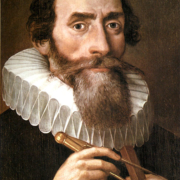Kepler: the first cosmologist
Johannes Kepler 1571-1630
Another view
Article by Dr Fred Starr PhD, FIMMM, FIE, MIMechE, CEng
Johannes Kepler was, arguably, the first and most important scientific son of Germany, long before it came to be a nation. Kepler was a true genius, who had to move from one country to another to earn a living and to avoid religious persecution, and he can also be claimed for Europe itself.
Kepler’s insight into how the planets move round the sun showed the need for a new physics of the Universe. That is, one that proposed a rational and testable scientific theory. Before Kepler, the belief that the sun, moon, planets and stars revolved round the Earth once a day, being kept in position with invisible rotating crystalline spheres, required no further discussion. Copernicus was stuck with circular motions for how the planets moved, as was Galileo.
Kepler started the evolution of thinking about the universe that still keeps professional astronomers busy. Their latest hang up seems to be whether it is black holes or dark matter that stops our galaxy flying apart. Kepler would have fully understood the quandary. His worry was what kept the planets orbiting the sun in elliptical, not circular orbits (a word created by Kepler). All this modern stuff is simply a development of the same kind of question he was asking of himself four hundred years ago.
How I first learnt of Kepler
I came to know about Kepler at the age of ten, when kindly Uncle bequeathed me a set of encyclopedias. I was immediately intrigued by Kepler’s three laws. The first was easy, showing that the sun was at one focus of an ellipse, with the planet following the curve. Kepler’s second law was a bit harder, the so-called equal area rule. Although I didn’t know it at the time, this was, in some respects, the most important, enabling Isaac Newton, half a century later, to show that it was gravity that kept the planets on track. The final law, stating that the cube of the distances of the planets was as the square of the times, was beyond my childish comprehension. What on earth could the square of the times mean? All became clear, when three years later, I began to learn algebra.
Newton, the discoverer of the Laws of Gravity, had a nasty side, brooking no rivals. In Principia, the book that put the sciences of mechanics and astronomy on their feet, he deigned not to mention Kepler. In contrast, Kepler seems to have been open-hearted to the point of innocence, and was eager to ask questions not only about the Universe, but of the Lutheran order that provided him with an education. What both men shared was an anorak approach to arithmetic and geometry. The time that they spent calculating how the planets and comets move defies description. Kepler’s Rudolphine Tables, incorporating 119 pages of hand-calculated spreadsheets (to use a modern term), were so accurate they became the go-to star and planetary atlas for astronomers, professional astrologers, navigators and geographers for the next 300 years. Each entry into the Rudolphine Tables was calculated by hand and brain, not Excel driven.
Kepler’s background
Kepler’s birthplace in the small town of Weil der Stadt, about 30 km from Stuttgart, was turned into a small museum as recently as 1999. Rather sadly, that suggests how his importance has been neglected in his native country. His first formal education was at the German Schreibschule in Leonberg, a few kilometres from his home town, where one would guess he was taught how to read and to work as a copyist – a profession whose future, with the development of printing, must have been stagnating!
More importantly, in terms of his future career, he migrated to Tübingen, ostensibly to study Lutheran theology, which required him to learn Latin. Here he fell under the influence of Michael Mästlin, a quiet proponent of the Copernican heliocentric universe. This excited Kepler’s interest in astronomy, and quite soon, at the age of 22 he found himself appointed professor of Mathematics and Astronomy at the Protestant School in Graz.
The five regular solids
It was here that Kepler had the revelation that the various planetary orbits were effectively held in place by a suitable combination of the five regular Platonic solids, the tetrahedron, dodecahedron, octahedron , etc. Although quite barmy, it caught the attention of Tycho Brahe, the man who had recorded the planetary positions more accurately than anyone before. Brahe was intrigued with Kepler’s mathematical skill, but I would highlight Kepler’s revelation for another reason. This was the first time that anyone in recorded history had come up with a physical mechanism for explaining why the planets were in their chosen orbits. Tycho Brahe had fallen out with his regal sponsors in Denmark and moved to Prague. Kepler was in difficulties with the Catholic authorities in Graz, and was expelled, so when Brahe invited Kepler to become his assistant in 1601, it was an opportunity not to be forgone. Brahe expected Kepler to rework his observations, producing a more accurate star catalogue.
Without Tycho Brahe’s incredibly accurate determination of the positions of the stars and planets, Kepler would have not been able to come up with his three laws of planetary motion. Doing his work before the telescope was invented, Brahe’s positions were roughly accurate to within a sixtieth of a degree. That is equal to one millimetre seen from two to three metres. Try it!
The conquest of Mars and what followed
Fortunately for the progress of science, as it would have been difficult for Kepler to follow his dream of finalising the Copernican or heliocentric vision of the Universe, Brahe died at the early age of 54, just a few months after Kepler had been taken on. It was then possible for Kepler to begin using the new data to accurately plot the orbits of the planets. The first planetary orbit that Kepler focused on was Mars. Brahe had accumulated a wealth of observational data. Furthermore, it was apparent that its orbit was not circular. After two years of solid work, the orbit was proved to be elliptical.
The years it took for Kepler to develop all three of his laws, were first properly described by Arthur Koestler in the “The Sleepwalkers- A History of Man’s Changing Vision of the Universe”, and you will find plenty of more recent stuff on the internet. However, I would just like to refocus on the point that I made at the beginning of this piece. That is, if the planets did revolve around the sun in elliptical orbits, there must be some cause.
We now know that it is a combination of inertia, which keeps the planets moving, and the gravitational pull of the sun. These were concepts beyond the thinking of Kepler, especially as he was stuck with the Aristotelian view that when something was moving, there has to be a force pushing it along. Kepler hypothesised that the sun was rotating. Accordingly, a force, rather like the spokes of a wheel, was spreading out from the sun, brushing the planets along.
Quite wrong of course, but quite certainly a science based rather than a mythological explanation, in which angels would be doing the work. This puts Kepler as the first proper cosmologist. And after all, to us laypeople, isn’t this idea just as rational as the planetary orbits being dictated by the bending of the space time continuum?
Further writings and publications by Fred Starr are available online at FredStarr.com
Editor’s Note: Kepler wrote his technical work not in German, but in the Latin language, at that time the lingua franca of the educated and clerical classes in Europe. This communication using Latin was a lasting legacy of the widespread Roman Empire which had collapsed nearly a thousand years earlier. Kepler’s foundational writings titled Astronomia nova, Harmonices Mundi, and Epitome Astronomiae Copernicanae would of course have been read by Sir Isaac Newton in the original Latin, but today are available to us in translation.
Further reading:
- Wikipedia page on Kepler’s Supernova
- Wikipedia page on Kepler’s book De Stella Nova
- Kepler’s book De Stella Nova
- Guardian article: The astronomer who saved his mother from being burned as a witch





